
Duplex Basket filters are installed where continuous operation is required, where the quantity of impurities is large and the line cannot be shut down for cleanout. When collected solids build up and impede flow, diverter valves permit the transfer of fluid flow without interruption from one basket to another. In this manner since isolated, the dirty basket can be removed and cleaned. These are available with an option of a manual changeover and automatic changeover of the valve in order to switch between one filter and the other. Duplex Basket filters are also available with automatic cleaning options as Duplex Auto Back wash filters where there is no need to remove the basket for the purpose of cleaning. These are also available with the option of a manual and automatic changeover of the valve.
We offer duplex basket filter with:-
- Twin 3-way valve design
- Sliding gate valve design
- Butterfly valve design
- Simply Basket Filter

Simplex Basket Filters are available in both Cast and Fabricated construction in inline and offset connections with flat bottoms or dish end as shell bottom. Each one of these filters are individually designed based on free flow area and pressure drop allowance values as required for the application. Various linings such as Rubber/PP/PVC/FRP/PTFE-FEP or any other epoxy can be done depending on applications, temperature, and pressure. These can be supplied with wedge wire elements or perforated sheet and wire mesh as filtration media.
- Manual Self-cleaning Filter
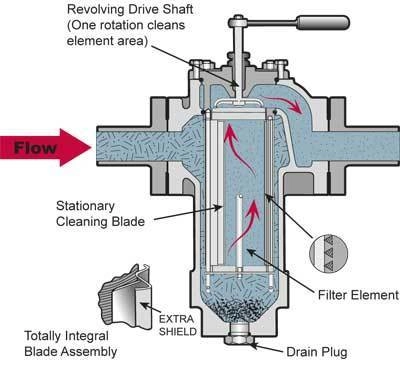
The liquid to be filtered enters through the inlet connection and passes through the specially engineered wedge wire element with the flow being from outside to inside. Solids larger than the selected micron spacing are either retained on the outside of the filter element or dropped into the filter chamber sump. The filtered liquid then passes through the top of the element and flows out through the outlet connection.
As the filter element becomes progressively fouled by retained solids the differential pressure across the filter rises. The element is cleaned by rotating the top handle manually or by motor and the scraper is provided on the surface of the filter element which scrapes out impurities deposited on the element. By three or four rotations, the element gets cleaned and impurities can be removed by opening the drain valve from the bottom. Suitable for large volume and fine filtration up to 30 microns available with single or multi-elements in body CS, SS 304, 316, 316L, or any other alloy steel material.
- Automatic Self-cleaning Filter
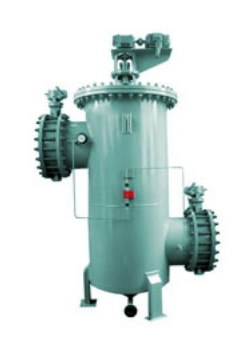
Liquid enters from the inlet, passes through the filter element, and gets out of the outlet of the Filter Nozzle. Differential Pressure (DP) Switch is provided across the Inlet and Outlet of the Filter. When the Filter Element gets choked Pressure Drop across the filter increases. Normally maximum Differential Pressure for backwashing is set at 0.5 Kg/cm2. When the Differential Pressure reaches the set limit the DP Switch gives a signal to the Control Panel (CP) and the CP gives a signal to the Motor and Electrically or Pneumatically Actuated Drain Valve. The Motor connected to the back 0 wash arm starts rotating 360 with 10 – 15 RPM; simultaneously the Motorized Drain Valve also gets opened to the atmosphere.
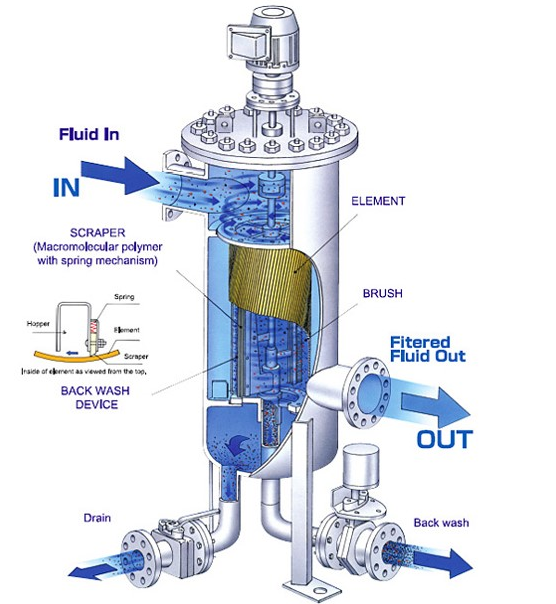
Backwash Arm is a hollow pipe and is connected directly to the Electrically Actuated Drain Valve. Whenever the open portion of the Backwash Arm comes in front of the Element a heavy Differential Pressure is created between the Backwash Arm and the Filter element. The water starts flowing in the reverse direction from Filter Element towards Backwash Arm since the valve is open to the atmosphere.
- Conical Type Filter
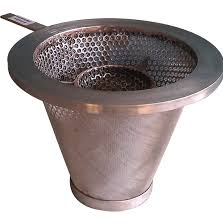
Conical Strainer consists of the suitably designed elements directly housed in a pipeline between flanged connections. Conical strainers are usually used in batch operations where the liquid flow may be interrupted periodically for cleaning and maintenance. Conical strainer elements are in fabricated types. Conical strainers are fabricated and designed as per ASME Section VIII Division 1. Sizing is based on the required filtration area for the given flow rate and the maximum allowable pressure drop. Various parameters like viscosity, density, operating temperature, degree of filtration determines the selection of a particular design of strainer element
- 'Y' Type Filter
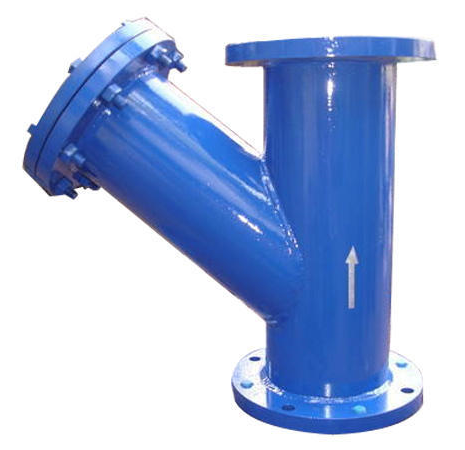
The Y-Strainer consists of Y shaped housing with suitably designed element. Y-Strainer are usually used in batch operations where the liquid flow may be interrupted periodically for cleaning and maintenance Y-Strainer are in cast/ forged form or fabricated types. Cast & forged strainer are designed as per ASME B 16.34, and fabricated type Y strainers are designed as per ASME Section VIII Division 1. Sizing is based on the required filtration area for the given flow rate and the maximum allowable pressure drop. Various parameters like viscosity, density, operating temperature, degree of filtration determines the selection of a particular design of strainer element.
- 'T' Type Filter
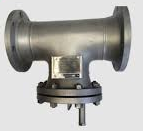
The TEE-Strainer consists of TEE housing with suitably designed element. TEE-Strainer are usually used in batch operations where the liquid flow may be interrupted periodically for cleaning and maintenance. TEE strainers are in cast / forged / fabricated types. TEE strainers are fabricated and designed as per ASME Section VIII Division 1/ ANSI B16.34. Sizing is based on the required filtration area for the given flow rate and the maximum allowable pressure drop. Various parameters like viscosity, density, operating temperature, degree of filtration determines the selection of a particular design of strainer element.
Get A Free Quote For Manufacturing & Fabricating
Contact us at the Industrial nearest to you or submit a business inquiry online.
Contact Us












